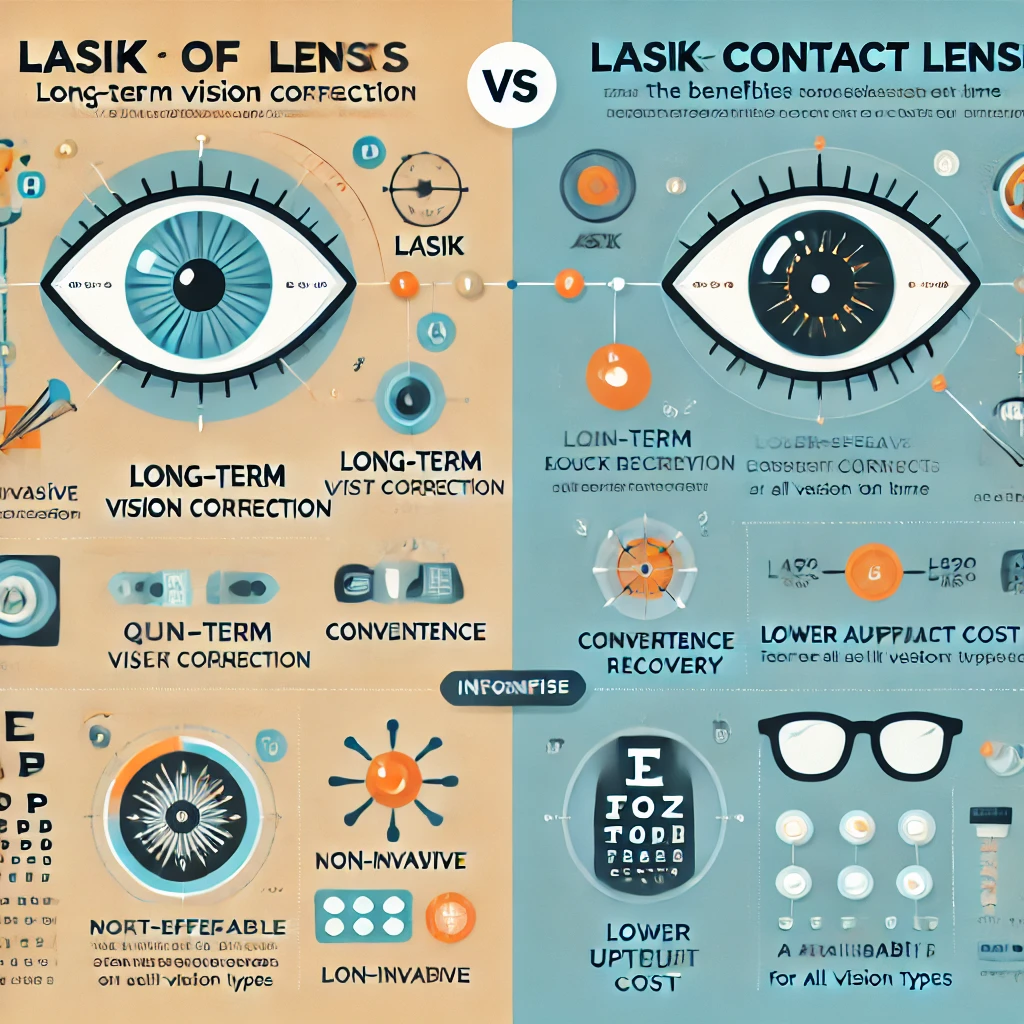

When it comes to vision correction, the two most popular options for people with refractive errors are LASIK eye surgery and contact lenses. Choosing between the two can be challenging, especially when considering factors like cost, pros, cons, and long-term health. This comprehensive comparison will help you weigh the pros and cons of LASIK vs. contact lenses, allowing you to make an informed decision on the best option for your vision needs.
LASIK (Laser-Assisted In Situ Keratomileusis) is one of the most popular forms of laser eye surgery. This procedure reshapes the cornea using a laser, allowing light to focus correctly on the retina. Many people opt for LASIK because of its convenience and long-term vision correction benefits.
Contact lenses are a popular and non-invasive method to correct vision, available in soft and rigid forms. They offer a variety of lens types to correct different refractive errors.

LASIK is a permanent solution for many individuals, often correcting vision to 20/20 or even better. Many patients report improved quality of life, as they no longer need to rely on corrective eyewear.
Once the healing process is complete, patients can enjoy a life free from the hassle of cleaning, inserting, or removing contact lenses. This is especially convenient for people with active lifestyles.
The surgery itself usually takes less than 30 minutes, and most patients notice significant improvement in vision within 24 to 48 hours.
Though the upfront cost of LASIK ranges from ₹1,00,000 to ₹2,00,000 per eye, it can become more economical over time when compared to the ongoing expenses associated with purchasing contact lenses or glasses.
Contact lenses require no surgery, making them a safer option for individuals who are not eligible for LASIK.
Contacts can be used daily or occasionally, depending on the wearer’s preference. They also allow for easy prescription changes as your vision needs evolve.
Initial expenses for contacts are lower, ranging from ₹10,000 to ₹30,000 annually, depending on the type and frequency of use. This can be an attractive option for people who prefer to spread out the cost over time.
The upfront cost can range from $2,000 to $4,000 per eye, making it a significant investment. However, some clinics offer financing options.
Like any surgical procedure, LASIK carries risks, including dry eyes, glare, halos around lights, and in rare cases, vision loss.
Certain individuals with thin corneas, unstable prescriptions, or severe refractive errors may not be good candidates for LASIK.
LASIK is usually recommended for those over 18 who have had a stable prescription for at least two years. It may not be suitable for individuals over 40 due to presbyopia (age-related near-vision decline).
Regular expenses for lens replacements, solutions, and cases can accumulate over the years.
Poor hygiene and improper care can lead to eye infections, corneal ulcers, and other complications.
Many people experience dryness, irritation, or discomfort, especially during extended use.
Contacts require daily maintenance, cleaning, and storing, which can be inconvenient for some users.

LASIK: The one-time cost of LASIK surgery can range from $2,000 to $4,000 per eye. However, this eliminates the ongoing expenses of purchasing contact lenses or glasses.
Contact Lenses: The cost of contacts varies depending on the type (daily, monthly, etc.), averaging around $200 to $500 annually. Over a 20-year period, the total cost can exceed $4,000, not including the cost of solutions and lens replacements.
LASIK: The main risks associated with LASIK include dry eyes, glare, halos, under- or over-correction, and very rarely, vision loss. While the success rate is high, some complications may arise.
Contact Lenses: The most common risks include eye infections, corneal ulcers, and irritation due to poor hygiene or prolonged wear. Improper use can lead to severe eye conditions requiring medical intervention.
LASIK: Once you’ve recovered from surgery, LASIK offers unparalleled convenience. You can wake up with clear vision and never have to worry about glasses or contact lenses again.
Contact Lenses: Contacts can be comfortable if used properly, but they require daily maintenance and are less convenient compared to LASIK. Many users find them uncomfortable for extended wear, especially in dry environments.

Age: LASIK is ideal for individuals aged 18-40 who have stable prescriptions, whereas contact lenses can be worn by people of all ages.
Lifestyle: LASIK is perfect for people with active or busy lifestyles who don’t want the hassle of maintaining glasses or contacts. Contact lenses might suit those who prefer a non-invasive, flexible solution.
Daily Routine: If you’re a frequent traveler, athlete, or have a hectic routine, LASIK can save you from the daily task of handling contacts or glasses.
Demographics: LASIK is becoming more popular among younger adults with steady incomes who can afford the procedure, while contact lenses continue to be favored by people who want a non-permanent or reversible solution.
When deciding between LASIK and contact lenses, consider the following:
Budget: Can you afford the upfront cost of LASIK, or do you prefer the smaller, incremental costs of contacts?
Comfort: Are you comfortable with a surgical procedure, or would you rather stick to a non-invasive option?
Lifestyle: Are you willing to deal with the maintenance of contacts, or do you prefer a more permanent, hassle-free solution?
Health: Are you a good candidate for LASIK based on your eye health and prescription stability?
Age: LASIK is ideal for individuals aged 18-40 who have had a stable prescription for at least two years.
Lifestyle: Active individuals who dislike the hassle of wearing glasses or managing contact lenses may prefer LASIK for its convenience.
Budget: While LASIK is a more significant upfront investment, it is more cost-effective in the long term compared to contact lenses.
Non-Surgical Candidate: If you are not a candidate for LASIK due to thin corneas, severe refractive errors, or pre-existing conditions, contact lenses are the best option.
Temporary Solution:If you prefer a reversible, non-permanent solution, contact lenses offer more flexibility in terms of prescription adjustments and daily wear.
For those not comfortable with LASIK or contact lenses, glasses remain a tried-and-true solution.
No Risk to Eyes: Since they sit on the nose, glasses have no direct contact with your eyes, reducing the risk of infections or irritation.
Ease of Use: Simply put them on and take them off—no need for maintenance or storage.
Fashion Statement: Glasses are also an accessory and come in various styles to match your look.
Limited Peripheral Vision: Glasses only cover a small portion of your visual field, affecting peripheral vision.
Inconvenience During Activities: They can be uncomfortable or impractical during sports, exercising, or outdoor activities.
Fragile: Glasses are prone to breaking or getting scratched and require regular adjustments.
Both LASIK and contact lenses have their pros and cons. LASIK offers a long-term, potentially permanent solution, while contact lenses provide a non-invasive, flexible option. Ultimately, your decision should be based on your vision goals, lifestyle, and budget. Always consult with an experienced ophthalmologist to assess your eligibility and discuss the best vision correction option for you.